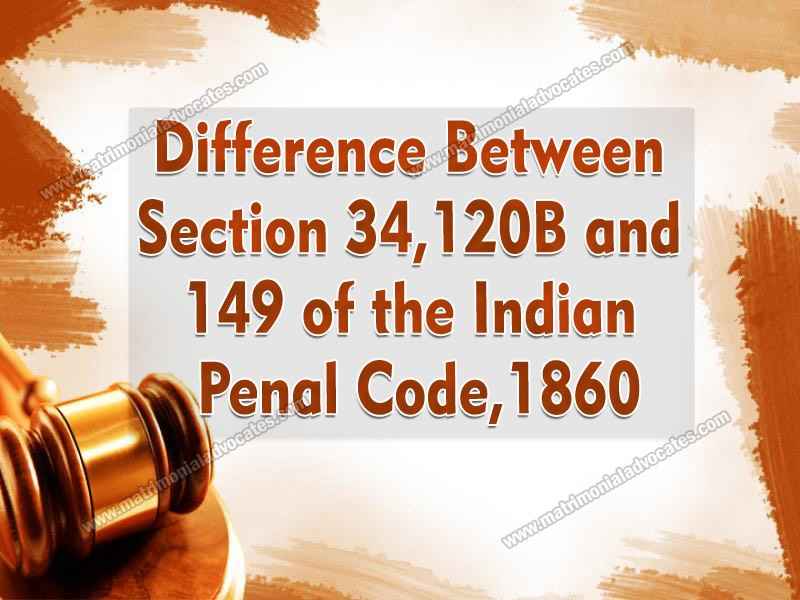
The present paper discusses the distinction between Section 34, 120B & 149 of the Indian Penal Code, 1860. Before distinction of these sections their object & facts that need to be established to bring the charge within the scope of these sections is also being discussed.
SECTION 34 IPC
Section IPC 34 states that when a criminal act is done by several persons in furtherance of the common intention of all, each of such persons, is liable for that act in the same manner as if it were done by him alone.
Object
The section is framed to meet a case in which it may be difficult to distinguish between the acts of individual members of a party or to prove exactly what part was played by each of them. The reason why all are deemed guilty in such cases is that the presence of accomplices gives encouragement, support and protection to the person actually committing the act.
Facts to be established
To apply section 34 IPC, there should be two or more accused and the following factors must be established.
a) The accused share common intention to commit the offence.
b) The accused accordingly participated in the offence.
c) The offence actually took place.
SECTION IPC 120B
IPC 120B states that 1) Whoever is a party to a criminal conspiracy to commit an offence punishable with death, [imprisonment for life] or rigorous imprisonment for a term of two years or upwards, shall, where no express provision is made in this Code for the punishment of such a conspiracy, be punished in the same manner as if he had abetted such offence.
2) Whoever is a party to a criminal conspiracy other than a criminal conspiracy to commit an offence punishable as aforesaid shall be punished with imprisonment of either description for a term not exceeding six months, or with fine or with both
OBJECT
The object with which this provision of law was brought to the statue books was to stuck down the intentions and plans to commit crimes. The intention behind the provision was to provide deterrence to persons agreeing or planning to commit offence.
Facts to be established
To bring the charge to within the scope of Sec IPC 120B, the following facts needs to be established:
a) That there was an existence of a design to commit an offence.
b) That such offence was punishable with imprisonment.
c) That accused concealed existence of such design.
• By his act or illegal omission or
• by his knowingly making false representation.
d) That he did voluntarily.
e) That he thereby intended to facilitate, or know that he would thereby facilitate commission of such offence.
SECTION 149 IPC
Section 149 of The IPC states that, If an offence is committed by any member of unlawful assembly in prosecution of common object of that assembly, or such as the members of that assembly knew to be likely to committed in prosecution of that object, every person who, at the time of the committing of that offence, is a member of the same assembly, is guilty of that offence.
OBJECT
This section is not intended to subject a member of an unlawful assembly to punishment for every offence which is committed by one of its members during the time they are engaged n the prosecution of the common object.
Facts to be established
a) That offence was committed by any member of the unlawful assembly; and
b) That such an offence must have been committed in prosecution of the common object of that assembly or must be such as the members of that assembly knew to be likely to be committed.
DIFFERENCE BETWEEN SECTION 34, 120B AND 149 IPC
ANALYSIS
- Section 34 and 120B IPC
The principle difference between these two sections is that:
- Under section 34 IPC, read with some other specific offence, a single person can be convicted because each is responsible for the act of all others, however it is not the case in Section IPC 120B.
- To bring the charge of common intention, the prosecution has to establish by evidence, whether direct or circumstantial, that there was plan or meeting of mind of all the accused persons to commit the offence for which they are charged with the aid of section 34 IPC, be it pre-arranged or on the spur of moment but it must necessarily before the commission of the crime .
However Offence of Criminal Conspiracy punishable under section 120-B of the IPC is a distinct offence. This section cannot be applied simpliciter unless and until some offence is disclosed. There cannot be any conspiracy without any offence. Section 120-B has to be appended with a primary offence. Thus, there cannot be any charge of conspiracy against any accused without the aid of substantive offence.
- SECTION 34 and 149 IPC
There is much difference Section IPC 34 and Section IPC 149. The principle differences are as such:
- Section 34 IPC does not by itself create any offence, whereas Section 149 does.
- ‘Common intention’ used in section 34 IPC is not defined anywhere in IPC, while ‘common object’ in s.149 must be one of the five ingredients defined in s. 141 of IPC.
- Common intention requires prior meeting of mind and unity of intention and overt act has been done in furtherance of the common intention of all.
However Common object may be formed without prior meeting of mind when the common object of the members of the unlawful assembly is one but intention of participants is different.
- The crucial factor of section ipc 34 is ‘participation’ while there is no need of active participation in s.149 of IPC.
DISTINCTION
| IPC 34 | IPC 120B | IPC 149 | |
| A) | Criminal act must be done by several persons in furtherance of the common intention of all. | There must be an agreement between the parties for doing an unlawful act. | That offence must be committed by any member of the unlawful assembly; and such an offence must have been committed in prosecution of the common object of that assembly. |
| B) | It lays down the Rule of evidence and does not create distinct offence. | Creates distinct offence and is by itself a substantive offence. | Creates distinct offence |
| C) | At least two persons are essential to share common intention. | At least two persons are essential for illegal agreement | At least five persons are essential to share common object. |
| D) | Creates constructive liability. | Does not create constructive liability or relationship like principal and agent since based on illegal agreement. | Creates constructive liability. |
| E) | Act must be result of pre-arranged plan. | No necessity of pre-arranged plan as gist of offence is mere engagement & association to break the law. | Pre-arranged plan is not required. |
| F) | Joint liability based on common intention | Liability based on illegal agreement | Joint liability based on common object. |
| G) | Actual commission of act is an offence. | Mere engagement to do an illegal act is an offence. Actual commission of illegal act is not necessary. | Actual commission of act is necessary |
| H) | Common intention need not be one of specified types only | Illegal act need not be one of specified types only. | Common object must be one of the objects mentioned in Sec. 141 IPC. |





